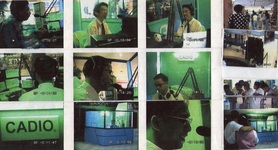Tested Innovative Entertainment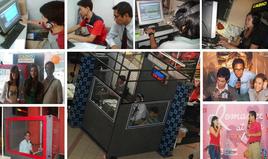
When Virra Mall stopped its operation on its "Virra Mall Radio, Paul Diesel (former DJ of Star FM), Big Brian (a former FM DJ of K91.5 FM) and Andy Gold proposed another management to them which did not materialized. In November 11, 1997, Andy started expounding the two ideas, mall radio/radiovision and boat radio which became "Cable Radio." The popularity of cable TV gave him the concept to make it "Cable Radio." Afterwards Andy asked Big Brian his partner to make the two words into one that would create an impact. He told Andy, Cable + Radio is "KADIO." Andy said, no; it should sound K-dio not KADIO. So in 1999, Andy Gold changed the pronunciation & made it K-DIO and spelled it CADIO. Here, they started marketing it.
CADIOaudioSystem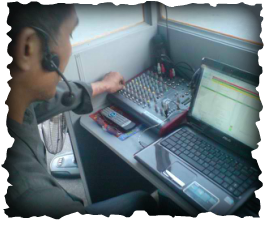
Sometime December of 1999, Big Brian and Andy Gold tried this innovation in three malls; Robinsons, Sta. Lucia and Metro Mall together with other DJs like Rick Stryker (a former FM DJ of Pinoy Radio DM 95.5), John Lemon (a former FM DJ of Magic 89.9 and Pinoy Radio DM 95.5), DJ Kris and Mark Detail (former FM DJ of Star FM). Another person who assisted and supported the audio system of CADIO during the tour was Jerry Roselada. They also got two sponsors, Goodyear and CMC Knorr. After the event, they ceased operating for awhile to pave way in making a research and development program. During that time, Andy wrote a letter addressed to AdBoard and PANA. He was told to seek membership in one of their constituent members, Advertising Suppliers Association of the Philippines (ASAP). When Nestor & Brian went to ASAP for a meeting, he was given an advice by its members including Mr. Jose Sy to come-up with their own association which was a complement. Meaning, cadio is considered a new advertising medium that cannot be placed in one of the members of AdBoard simply because it's a different one. Aside from that, Andy was also motivated by different media buyer heads (media directors, managers, buyers, etc.) to push and keep on improving the innovation. Having those pieces of advice, Nestor finished writing his book entitled "What you must know about... CADIO, Philippine Copyright 1999."
|
CADIOboothSystem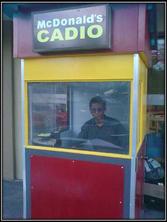
In 2003, Andy called-up Big Brian about the cadio business and told him a project that he wanted to enter. During the conversation, Big Brian thought of the idea of having an exclusive booth system. Meaning, a client can have its own version of a special designed booth like a hamburger (e.g. McDonald's). Andy started to recall his experiences in PICO Arts (a contractor of booth system and special design booths) as Project Manager back in 1996 to 2000. Andy also tried working as a freelance host for SM supermalls & other events for two years, to gain more ideas on "Event Management." Then this became the start of the ironed innovation of "cadio." It doesn't only play spot commercials but also gives emphasis on its booth ad system. Because of it, he made another book entitled "CADIO Advertising, Philippine Copyright 2004."
Production House & Digital Media Devices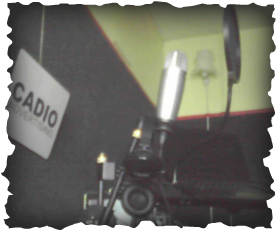
Last 2006, cadio was rebuilt with the help of Nestor's friends Ogie and Nep Caja whose advertising company "Maya Advertising & Omnisource" has been in the industry for more than 23 years. Their line of business was outdoor, indoor and events advertising. Cadio had an event with them at the "Auto Summit 2006," a car show done at Festival Supermall last June 17, 2006.
Later on, cadio had an opportunity to test its efficiency in four McDonald's stores in Metro Manila. Fortunately, cadio passed the evaluation. Then CADIOcannedProgram was introduced, a pre-recorded music and commercial program on CD/Flash Drive/mp3 player that can be played in different places. This would sound like an FM radio inside an outlet once a customer or anybody hears the music and the advertisers' commercials. At present, CADIO Advertising is doing a research and development on future CADIO products and services. On the other side, CADIO team will keep on developing new ways to serve the huge narrowcast market. We have Eric, Boo, Brian and me on the team... According to John Wanamaker and he quotes,
"Half the money I spend on advertising is wasted; the trouble is I don't know which half." |
The FutureChange is so dynamic. Game change in advertising is taking place. It's the theme of the 22nd Ad Congress, "Change the Game." The pacing is getting faster and some industries will lose its market but new business opportunities in advertising will continue to exist. In the biblical point of view, Daniel wrote (Daniel 12:4) that many will go here and there to "increase knowledge.” So, expect new ideas, inventions and innovations will occur tomorrow.
Basically, it all started from Digital Media. Different terms are existing every now and then. An upcoming service that we have is the CADIOnetProgram that will be done in a Multicast approach. Manny Pangilinan is using the term New Media for his campaign. Paul Sales who has been a broadcaster for more than 15 years has shared some thoughts on Multi-platform Series and Terrestrial Media which is considered as Digital Multimedia Broadcasting. The CADIO innovation has gone through a long research and development which will transform its term later to CADIOVISION. This is another Filipino innovation that is similar with the above mentioned highlighted terms. We can't give the exact definition of our terms yet because it falls under "trade secret." Likewise, it's an intellectual property. |
Why wasted? Maybe because an advertiser cannot witness the target market viewing or hearing his commercial. If the dissemination of messages through video, audio or image are done in a "private captive market;" then how can an advertiser justify that his commercial was seen and heard by his target market? PPM or diaries are the methods in making surveys; but what if there are two companies doing it and they showed different ratings? Is it still credible? Well, the internet has made a solution to that. So when you watch You Tube videos, you can see the hits or the number of viewers who have watched the video. Now if there is no way to come up with such system like with the internet; then the only way is through "public captive market," and this can be done by "Narrowcasting using CADIO."
|
|
Here, an advertiser can witness his target market. Unfortunately, an advertiser can't witness all his target market viewing and hearing his commercial at the same time in narrowcasting but at least, it can be justified. So, real value in this sense is when you can witness your target market watching, seeing and hearing your commercial or ads. If you know other solutions, good for you. If you need a narrowcasting solution; then you need to give us a call and it would be a pleasure assisting you in our own little way.
|
